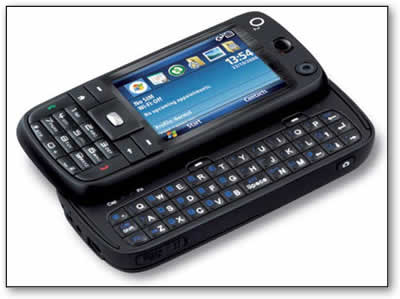O2 Atmos
If you want the power of a Windows mobile smartphone without the bulk, this compact handset should be on the shortlist.

The O2 Atmos is a great little package and though it does lack features it's the usability that really stands out. The lack of GPS means some will want to go for the larger Tytn II, but if you want a serious business device for use during the day and something you wouldn't mind taking down the pub in the evening this will hit the spot.

For a company that just a few years ago was unheard of, HTC has made quite a name for itself. Ever since the introduction of the first Windows Mobile device - the Orange SPV, it has been steadily rolling out impressive designs that have been taken up by all the major hardware vendors.
Most recently, in the business space, HTC has had success with the Tytn II, a Pocket PC based Windows Mobile that offered an impressive range of features. Of the three networks it was available on, O2 was the last to releases a version of the Tytn II, which it branded the Stellar, but it has made up for this tardiness by being the first to get HTC's latest, the S730, branding it the Xda Atmos.
When the specs of the S730 were released I was intrigued as it appeared to offer virtually the same features, as the Tytn II, such as the signature sliding keyboard, global quad-band GSM and 3.6Mpbs HSDPA connectivity and a screen with the same 240 x 320 resolution, although smaller at 2.4in. All this though, comes in a compact shell and the addition of a keypad, instantly rendering it more practical.
However, there are key differences. Firstly, the Atmos is powered by Windows Mobile 6 Standard for Smartphones, rather than Pocket PC Professional, which means the keypad comes at the expense of the touch screen and stylus, though really not requiring the latter should be viewed as a benefit.
The Atmos also lacks GPS - despite it being present on the chipset. Indeed, it's even picked up by programs that can make use of it, such as Google Maps, but does nothing as it's not been enabled, with reports suggested that the aerial in missing. Why HTC did this is open to speculation and my guess would be at the request of O2 to act as a differentiator to the Tytn II/Stellar and to help prolong battery life.
Next is that keyboard - it slides out from underneath the keyboard but it doesn't tilt, so if you're hung up on the Tytn II's party piece then you'll have to pass on the Atmos.
That would be churlish though as lack of GPS aside, the Atmos is a very impressive device. The dimensions of 51 x 105.8 x 19.4mm, are less than that of O2 Stellar, while it's lighter too at 150g, compared to the Stellar's 190g. These smaller dimensions make an appreciable difference - while it's no thinner, it's shorter and narrower, making it easier to pocket.
Get the ITPro daily newsletter
Sign up today and you will receive a free copy of our Future Focus 2025 report - the leading guidance on AI, cybersecurity and other IT challenges as per 700+ senior executives
Benny Har-Even is a twenty-year stalwart of technology journalism who is passionate about all areas of the industry, but telecoms and mobile and home entertainment are among his chief interests. He has written for many of the leading tech publications in the UK, such as PC Pro and Wired, and previously held the position of technology editor at ITPro before regularly contributing as a freelancer.
Known affectionately as a ‘geek’ to his friends, his passion has seen him land opportunities to speak about technology on BBC television broadcasts, as well as a number of speaking engagements at industry events.
-
 Westcon-Comstor and Vectra AI launch brace of new channel initiatives
Westcon-Comstor and Vectra AI launch brace of new channel initiativesNews Westcon-Comstor and Vectra AI have announced the launch of two new channel growth initiatives focused on the managed security service provider (MSSP) space and AWS Marketplace.
By Daniel Todd Published
-
 Third time lucky? Microsoft finally begins roll-out of controversial Recall feature
Third time lucky? Microsoft finally begins roll-out of controversial Recall featureNews The Windows Recall feature has been plagued by setbacks and backlash from security professionals
By Emma Woollacott Published
-
 The UK government wants quantum technology out of the lab and in the hands of enterprises
The UK government wants quantum technology out of the lab and in the hands of enterprisesNews The UK government has unveiled plans to invest £121 million in quantum computing projects in an effort to drive real-world applications and adoption rates.
By Emma Woollacott Published